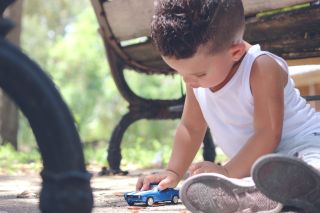Depression
The Simple Key to Strengthening Your Bond with Children
What is "curious waiting," and why do we need it?
Posted December 14, 2022 Reviewed by Devon Frye
Key points
- Curious waiting helps children of all ages feel seen and heard.
- Especially when children are anxious and depressed, curious waiting is a key way to to check in.
- When we want to have a memorable interaction with kids, quiet time and flow are key.
- This method of interacting with kids doesn't have to involve a lot of time.
.jpeg.jpg?itok=jVyWWY3e)
Recently, I asked my eleven-year-old daughter to tell me a memorable thing that happened this year. It was December. We were out on our regular fifteen-minute walk to the local café. She’d just returned home from a school trip. She’d done gymnastic camp, and swim lessons, and birthday parties. But what she said surprised me.
“Just this.”
“What do you mean, ‘this’?” I asked her.
“This.” She smiled. “Just this walking. That’s was memorable.”
“Just….walking?”
“Not just walking.” Her smile broadened. “It’s that you’re listening. We can talk about anything. I can say whatever I want to say.”
This surprised me at one level, but on another level, it didn’t. In a rushed world, with so many priorities, it can feel quite uncommon to take the time for this kind of conversation. Especially now, with the holiday season in full swing, having so many priorities can make it hard to slow down. But kids benefit from this slowing down—and what’s more, they need it.
The Need for “Curious Waiting”
Coming out of a pandemic, many kids are feeling truly isolated and stressed, as are adults. According to a recent national survey, over 75 percent of schools last spring said teachers and staff have mentioned concerns about student depression, anxiety, and trauma. [1] As the title of a recent Washington Post article argues, “The crisis of student mental health is much vaster than we realize.” [2]

There are startling rises in childhood depression anxiety and isolation, starting young. ER visits to the emergency rooms for mental health visits have jumped, even before the pandemic. Many children are saying they feel anxious, stressed, and depressed; that they don't have real friends or deep relationships, even as they are surrounded by people.
The same goes for many adults. We are facing a true crisis from both kids and their nurturers, guardians, and caretakers—and these two crises are related.
We All Need a Fresh Approach
It will take far more than a few conversations to support children’s mental health. But these conversations are a critical start. They help us check in with kids. They give kids time to voice what’s on their minds. And they set a foundation to teach kids that there’s always an open door to talk, whether they’re excited, or anxious, or depressed.
So how can we have these kinds of conversations? In my own work, I’ve developed an idea called “curious waiting” to help. This idea is drawn from Maria Montessori’s principles, as she talks about the need to “follow the child.” But it adds in the language component, helping us have these interactions in our everyday talk.
You can see this strategy as helping, no matter a child’s age. Whether a child is two years old or eighteen, you can still make room for these conversations every day. It only takes five or ten minutes—and it's a key to bonding better. As I’ve seen with many teachers and parents, it can also enhance your interactions with other adults.
What is Curious Waiting?
“Curious waiting” is deceptively simple. It involves only two main components: the curiosity and the waiting. It sounds like almost nothing, but we need it more than ever. Curious waiting is a radical act in a society that wants us to go further faster.
Having downtime and wait time isn’t only important for mental health. It’s also critical for deep thought and creativity. We know Einstein, for example, based many of his most important ideas on visualized thought experiments, including, for example, bubbles. To develop his ideas about the speed of light, he imagined light moving in his mind.

First, the waiting. Think about sitting—or walking—mindfully with a child. Simply stay silent and observe what they’re doing. Notice not just the activity, but what interests them about it.
Consider the concept of “joint attention,” a term typically used for young children, when we look together at one thing and talk about it. You can try this with any age child. Notice where their attention goes. This allows for a child-focused conversation, where you start with what interests a child, or what’s on their mind.
We can’t do this all the time, of course. But try it a couple times a day, when kids are calm. Take five or ten minutes. Sit and let go of what you are thinking about and of what you’re doing. Or do something quiet in the background, like cooking or knitting or fixing something that’s broken. Let the child lead the conversation.
In my work, I talk about the A-B-C-s of conversation. Purposeful conversations are often Adaptive, responding to a child’s temperament and mood. They involve a back-and-forth between adult and child, or between children. And they’re child-driven.
This waiting allows for all three. We have the chance to notice a child’s energy. We make space for more of a back and forth, not talking at kids, but with them. We can start conversations with what kids are interested in or worried about. These are key to meaningful talk.
Second, the curiosity. Try wondering aloud about what a child is doing. You don’t need lots of language or tons of questions. Try “What’s that about? Or “tell me more.”
Or try these three Es. Expand on a child’s sentences. Add words or ideas. Then, explore beyond the here and now. Encourage a child to predict what will happen or imagine new possibilities. Then evaluate how the child’s strategies are working or how they like what they’re doing. For example: “What part of that is your favorite?”
Why is this approach so powerful? It lets a child feel they have good ideas. It lets them describe what they are thinking about or feeling. And it can give us a moment to pause and think deeply about what they are interested in—and what interests us.
We Have Misconceptions About Curiosity
Curiosity isn’t about asking a million questions, or constantly probing kids, “What’s that? What’s this?” It has much more to do with helping a child get into flow, then following the line of a child’s questioning. Try questions like “What if we tried this?” or “How might we see it differently?” Or sit in silence with occasional check-ins.
In silence, you’re giving the child room to think—and you’re taking a moment of silence for yourself. While you might not share the child’s interests, it’s mindfulness practices like these that can benefit your work life, your creativity, even your happiness, especially if you don’t have a lot of downtime. As one Harvard study found, we’re only rarely focused on one thing at a time—and constant multitasking is linked to unhappiness. [3]
So the next time you’re with a child, practice the art of curious waiting. See what comes up. And then, the next day, try it again. See if you find you have more interesting conversations afterward, feel more bonded, or even understand the child more in front of you more.




